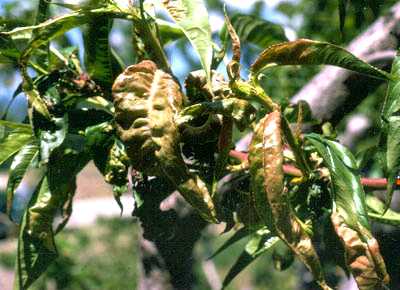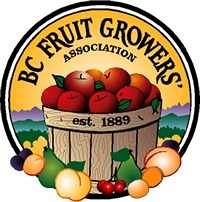Peach Leaf Curl
General Description
Peach leaf curl is a disease of peach and nectarine, caused by the fungus Taphrina deformans. It is favoured by prolonged wet, cool weather in the spring as new growth is developing.
Symptoms:
Infected leaves become thickened, curled and discoloured, and eventually dry up and drop. Heavy leaf infection and subsequent leaf drop may reduce crop and tree vigour.

Peach leaves infected with peach leaf curl fungus. (BCMA)
Life Cycle:
Leaves are only susceptible to leaf curl infection between bud break and petal fall. Fruit can also be infected following long rainy periods for a short time following petal fall. Young leaves are infected by blastospores (yeastlike spores) that survive and multiply on tree surfaces. During early spring, rising temperatures and wet weather allow the fungus to multiply and infect buds and emerging leaves. Leaf symptoms typically appear about 3 weeks after infection, but this can vary depending on temperature. For the remainder of the season the leaf curl fungus survives and multiplies on leaf and tree surfaces and becomes part of the normal mycoflora of the tree.
Management
Cultural Control
Sanitation, such as removal of infected leaves, is NOT effective for control of leaf curl.
No variety is immune to leaf curl, but ‘Redhaven’ and most varieties derived from ‘Redhaven’ have some tolerance.
Chemical Control
Spring Dormant: For best control, apply one of the following fungicides before bud development begins in the spring. Late application up to petal fall may provide partial control. Only developing leaves are susceptible to leaf curl infection. Fungicides applied after petal fall will not help to control leaf curl.
Fall: A spray of fixed copper (Copper Spray or Copper Oxychloride 50) applied after harvest in September will give adequate control of peach leaf curl in dry years. However, in wet years the late winter dormant spray listed above is also needed. Chlorothalonil may also be applied as a fall dormant spray at 75-100% leaf drop. Note: Do not apply chlorothalonil more than 3 times per year.
PDF version - peach_leaf_curl.pdf (gov.bc.ca)
Updated: July, 2018
